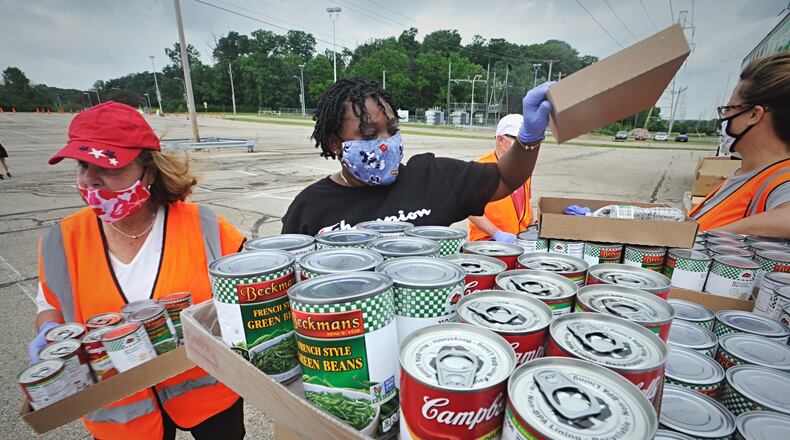Anti-poverty groups and hunger relief organizations say food insecurity is going to dramatically intensify across the region and state because the extra $600 per week jobless workers received ran out at the end of July.
The first unemployment checks without the beefed-up payments were sent out last week in Ohio, and tens of thousands of people across the Dayton region who just lost a major chunk of their income may start turning to local food banks and the food stamp program to help stock their fridges.
“If this economic safety net for displaced workers is not extended, we would expect surging demand for help with food, both from our emergency hunger relief network and through increases in SNAP (food stamp) participation,” said Joree Novotny, spokesperson with the Ohio Association of Foodbanks.
President Donald Trump on Saturday signed executive actions intended to provide $300 per week in additional federal payments to jobless workers, and directed states to provide an extra $100 per week.
In May, just 10 of Ohio’s 88 counties saw an increase in food stamp recipients, according to this newspaper’s analysis of the most recent data from the Ohio Department of Job and Family Services.
Hamilton County saw the largest increase of 2.5%. Montgomery County saw 1.8% growth.
Participation in the food stamp program grew 1.3% in Greene County; 1% in Butler County and 0.7% in Warren County. The program’s official name is the Supplemental Nutrition Assistance Program.
In April, food stamp participation shot up by about 23% both across Ohio and the seven-county Miami Valley region.
That followed widespread job losses, due to the COVID-19 economic shutdown.
Credit:
Credit:
Since the start of the pandemic, food banks and pantries have been inundated with new clients and have had to deal with very long lines.
The Food Bank Inc. in Dayton says it saw a 68% increase in the peak of March/April of new families who were not in its system who were seeking food assistance for the first time.
Hunger is a major issue in the Dayton region in normal times. But unprecedented job losses has greatly compounded the problem.
But hunger and poverty have not been nearly as bad as they could have been, because laid-off workers were receiving an extra $600 per week in unemployment benefits that Congress approved as part of coronavirus stimulus packages, advocacy groups said.
In fact, statewide about 1.4% fewer people received food stamp assistance in May, compared to April.
But the expiration of the enhanced benefits will mean more hardship for Ohio families, said Novotny, with the Ohio Association of Foodbanks.
Food is one of the only costs in Ohioans’ household budgets that bill collectors don’t come after, so it’s often the first expense sacrificed to make rent and keep the lights and utilities on, she said.
Many new Ohio households are expected to qualify to participate in the food stamp program, because their incomes without the extra $600 per week will fall below the eligibility threshold. Ohioans may qualify for food stamp benefits if their household gross monthly income is at or under 130% of the federal poverty guidelines.
“Needless to say, SNAP is not funded sufficiently to even begin to make up for the loss of wages or unemployment benefits families are experiencing,” Novotny said. “And while SNAP is our most critical line of defense against hunger, it cannot pay the rent or mortgage or even buy diapers.”
Food insecurity and demand for food assistance will rise as the virus spreads and more people get infected, laid off or lose benefits, said Michelle Riley, CEO of the Food Bank Inc.
“SNAP is always the first and most impactful help for families who do not have enough money to put food on their tables,” she said.
Since the enhanced unemployment benefits have expired, all nonprofits who work in the “social determinants of health:” will see an increase in demand for basic services, Riley said.
She said she’s most worried about community members who do not know how to access the food assistance system and seniors who have no care givers.
The enhanced unemployment benefits were pumping tens of millions of dollars each week into the local economy.
In the week ending Aug. 1, about 52,290 people received unemployment compensation in Butler, Champaign, Clark, Greene, Miami, Montgomery and Warren counties.
The average unemployment compensation payment in June in Ohio was about $945, said Bret Crow, communications director with the Ohio Department of Job and Family Services.
For the indefinite future, the average payment is expected to be around $345.
Using that $945 estimate, the unemployment insurance program injected about $49.4 million into the Miami Valley region in the week ending Aug. 1. Without the extra $600 boost, the program would have paid out about $18 million to local unemployed workers.
Federal lawmakers are still debating another stimulus package, and enhanced unemployment benefits are a major topic of negotiations.
On Saturday, Trump took executive action to provide $400 per week in enhanced benefits, including $300 per week from the federal government and $100 from state programs.
CBS News said that spending measures usually require actions by Congress, and Trump’s orders could end up being challenged in court. Some Democratic lawmakers and others have questioned whether the president has the authority to extend additional benefits.
Some Republican lawmakers say they oppose providing the extra $600 per week, because they say many workers earn more from being unemployed than they would by working, which provides a disincentive to seek re-employment.
Some lawmakers say they would want to cap enhanced benefits at around 70% of what workers earned before they were laid off.
Other groups and individuals, including Democratic politicians, say the real problem is there are no jobs to return to, and the boosted payments are a lifeline until the pandemic is under control and the job market stabilizes.
About the Author


